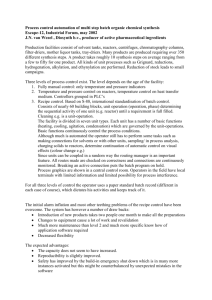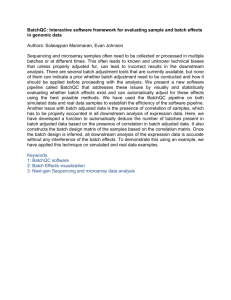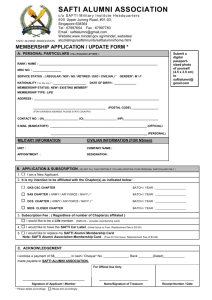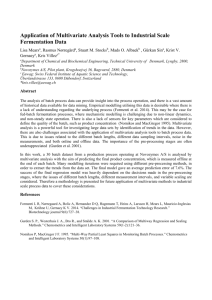Production Cost Analysis
advertisement
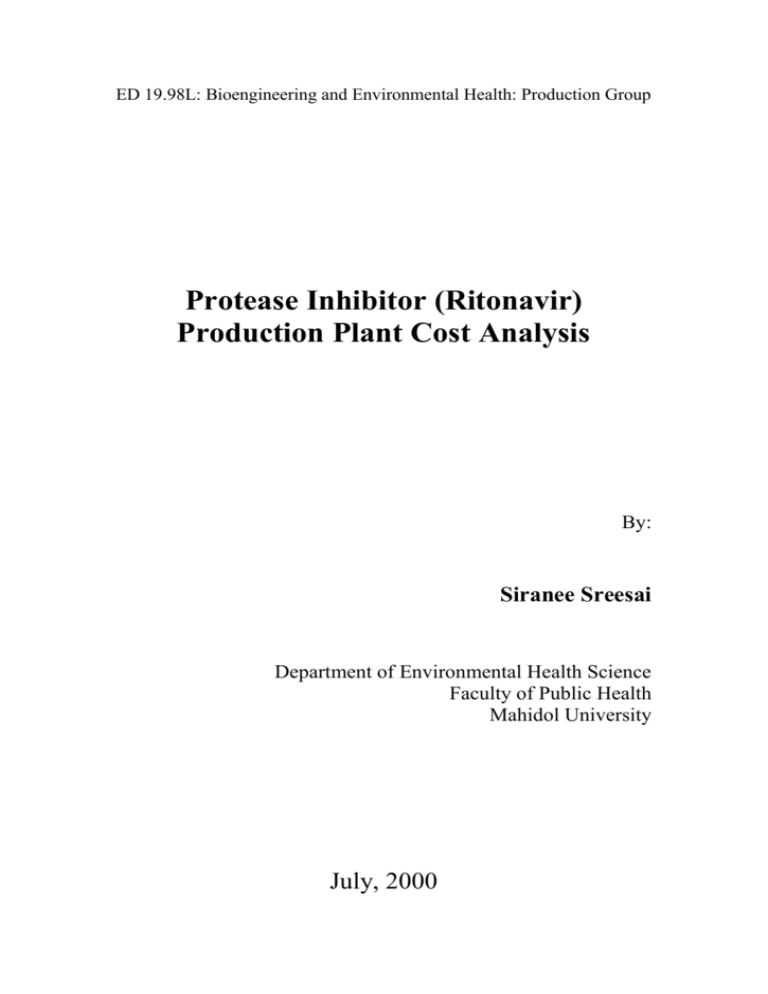
ED 19.98L: Bioengineering and Environmental Health: Production Group Protease Inhibitor (Ritonavir) Production Plant Cost Analysis By: Siranee Sreesai Department of Environmental Health Science Faculty of Public Health Mahidol University July, 2000 Siranee Sreesai 1. Introduction Production cost analysis is one part of micro-economic analysis. It has been performed in order to assess the feasibility of production to serve patient needs. Figure 1 shows the entire system of production, which cost of every activity has to be analyzed. All the determined costs are used for defining the optimum production capacity and prioritizing costs among production activities. The analysis results will be used for maximizing benefits of public health, economic and environment. Process Equipment/Plant Infrastructure Water Electricity Fuel Oil, Gas Admin Production Maintenance QC/QA Imported chemicals Synthesis Other Raw Materials Packaging Materials Purification By Product Product Waste Packaging Waste Treatment Distribution The protease inhibitor, Ritonavir, is selected for this study. This report is focused only on production cost which come from the capital investment and operating costs. The computer program namely SuperPro Designer (version 4.32) has been used for the synthesis processes simulation and economic evaluation. According to the program, all of database for cost analysis is designed base on U.S. basis at the prices of year 2000. Since the production group members agree to locate the production plant in Thailand, these acquired results have to be recalculated again in the future in order to fit with Thailand situation. Due to the limitation of database relating to the market needs, economic and SuperPro Designer computer program knowledge, time and other constrains, the report may not give the accurate numbers of production costs. However, it is very good learning experience for the beginner and this could express some critical issues for producer. -1- Siranee Sreesai 2. Production Cost There are two major costs of production, capital investment and operating costs. The capital cost comprises of 1) Direct cost which is also called the physical cost. These are the components, which are physically noticeable when one considers a production plant. The bricks and mortar of the building, the stirred vessels, mixers, distillation column, ultra-filter, and so on that needed to run the chemical processes, and the piping to transfer the chemical streams all fall into this category, 2) Indirect costs which are often overlooked piece of the overall plant cost. These are the fees, which are needed to make the physical structure possible including engineering fees and contractor fees. Contingency cost is also belonging in this group. Operating cost are those variable costs which are calculated from 1) Raw materials. There are various chemicals used such as dimethyl sulfoxide, oxalyl chloride, dichloromethane, citric acid and others. The selected chemicals and other raw materials have to have good quality in order to minimize waste generating and reduce production costs as the whole. 2) Labor costs. There are several level of hired human resources such as worker, technician, engineer, scientists ect. Each kind of labor has different costs and hired conditions. Thus, the labor cost is differ depends on norm of production company and law of the country. 3) Equipment related which include upkeep, cleaning between batches, replacing malfunctioning parts on the expensive machinery. Due to the large amount of machinery in this plant, this maintenance cost is expected to be around 5% of equipment cost per year. 4) Quality Assurance (QA)/Quality Control (QC). QA/QC include cost for auditing system, chemical inventory and others. 5) Utilities and consumables. Utilities are power, water and fuel. Consumable material are filter materials, resins etc. 6) Transportation. The transportation cost covers the cost for all kind of transport for raw materials, products and by-products. If there are many imported materials from outside the country, this cost will be the critical part of production cost. 7) Waste treatment/disposal. The concern of environment friendly production is needed and will make the acceptable and successful production. Beside this, there are other important environmental management such as the work on occupational health and safety, environmental monitoring and by-product management. They also contribute significant reduction of production cost from intervention of waste minimization and by-product management. 8) Miscellaneous. 3. Steps for Production Cost Analysis There are 12 important steps required for production cost analysis. 3.1 Know chemicals and raw materials to be used and operation steps such as store, blend, reaction, homogenization, chromatography, distillation, extraction, drying, absorption, filtering and packaging. The synthesis processes are acquired from published literature and patents. -2- Siranee Sreesai 3.2 Choose the operation process. The production can be either batch or continuous process. In this case, the batch operation is selected. 3.3 Make flow sheet. From the synthesis processes simulation of Ritonavir, there are 9 sections of production process (see process flowsheets from report of Ratanachoo K.). 3.4 Solve mass balance and energy balance to know: Ratio of various chemicals to put into process, and when to put in, What are the chemicals, by-product or waste obtained from the process, How much energy to put into each step to initiate reactions and How much energy to obtain from each reaction step 3.5 Obtain quantity of each raw material for the required throughput and the cost 3.6 Obtain amount of energy to be used and the costs 3.7 Obtain size of equipment to be used in each process step, and the cost of equipment 3.8 Obtain waste treatment process and the cost 3.9 Know what to do/check/analyze, and how many people needed, obtain labor cost 3.10 Adjust process flow sheet if necessary 3.11 Calculate costs, obtain unit cost 3.12 Sensitivity analysis and scale-up or scale-down to get the curve “Economy of Scale” 4. Summary of Production Cost Base on assumption of drug production for 30% of HIV positive patients in Thailand, the amount of Ritonavir production rate is 93,138 kg/yr. Using flow diagram from the design of Ratanachoo K. and follow the steps in topic 3, then cost analysis has been performed by SuperPro Designer computer program. Capital investment and operating costs are summarized below: 4.1 Total capital investment 120,649,000 $ 4.2 Operating cost 192,202,000 $/year 4.3 Production rate 83,546 4.4 Unit production cost 2,301 -3- kg/year $/kg Siranee Sreesai Batch size is 309 kg and production is estimated at 270 batches per year. Table 1 and 2 show detailed capital investment and operating cost for the whole steps of Ritonavir production. Table 1. Capital Investment Cost Item Cost ($) 1. Total Plant Direct Cost Equipment purchase cost Installation Process piping Instrumentation Insulation Electrical Buildings Yard improvement Auxiliary facilities 54,815,000 16,562,000 7,115,000 5,797,000 6,625,000 497,000 1,656,000 7,454,000 2,485,000 6,625000 2. Total Plant Indirect Cost Engineering Construction Contractor’s fee Contigency 46,045,000 13,704,000 19,185,000 4,386,000 8,770,000 Fixed Capital Cost Working Capital and Startup Cost Total Capital Cost 100,859,000 19,790,000 120,649,000 Table 2. Operating Cost Cost Item $/year % Raw materials Labor-dependent Equipment-dependent Laboratory/QA/QC Consumables Waste treatment/disposal Utilities 153,608,000 7,293,000 18,975,000 1,094,000 9,947,000 1,174,000 108,000 79.92 3.79 9.87 0.57 5.18 0.61 0.06 Total Operating Cost 192,202,000 100.00 Note: This operating cost does not include transportation, advertising and selling, running royalties, failed product disposal, and miscellaneous expenditures. -4- Siranee Sreesai To address major costs, each reaction is analyzed in detail. There are all together nine-reaction steps in which chemicals are added, mixed, and processed as shown in the flow diagram of Ratanachoo K. Each reaction step has different operating cost since there are different chemicals, and different equipment to run the process as summarized below: REACTION STEP RX1 RX2 RX3 RX4 RX5 RX6 RX7 RX8 RX9 OPERATING COST ($MILLION/YEAR) 67.7 5.4 36.2 7.4 33.1 27.8 1.4 10.7 2.4 OPERATING COST OF EACH REACTION STEP RX7 RX8 RX9 RX6 RX1 RX5 RX2 RX4 RX3 From the graph, reaction step 1 is the most expensive operation. Operating cost in this step is $ 67.7 million per year. The next expensive steps are reaction step 3 and reaction step 6 respectively. In order to see detail in the step 1, detailed operating costs are illustrated below: RX1 OPERATING COST TYPE RAW MATERIAL LABOR WASTE TRT/DSP EQUIPMENT DEPENDENT LAB/QC/ QA CONSUM ABLES UTILITIES $ MILLION/YEAR 64.1 1.6 1.2 0.6 0.2 0.0 0.0 OPERATING COST /YEAR FOR RX 1 BY COST TYPE RAW MATERIAL LAB/QC/QALABOR -5- Siranee Sreesai Raw material, various kinds of chemicals, is a major cost in this step since this is the first step of the process where most of the chemical is fed. In general, main operating cost in other step is also from raw material. The organic solvents and chemicals used for synthesis contribute to about 60% of raw material cost. Capital investment is also analyzed in the same way, reaction by reaction as show below: REACTION STEP RX1 RX2 RX3 RX4 RX5 RX6 RX7 RX8 RX9 INVESTMENT COST ($ MILLION) 0.4 0.7 5.4 0.4 0.4 2.9 0.5 1.8 0.8 INVESTMENT COST OF EACH REACTION STEP RX 9 RX 1 RX 8 ($ MILLION ) RX 2 RX 7 RX 3 RX 6 RX 5 RX 4 Reaction step 3 has the most cost of equipment since there are the biggest Gel Filtration and Drum Dryer units here. Reaction step 1 has less cost although operating cost in this step is highest. Comparing all costs, it is obvious that cost for raw material is the highest priority to be focused. Thus, keep as less raw material as possible on site would be critical to decrease operating cost to hold the raw material inventory. Just In Time delivery and good logistics practices for the raw material and finished product would be important to keep financial healthy. 5. Sensitivity Analysis Since basis for the process design is that we would produce 93,138 kg/year, then what if we produce only 50% or even 25% of the above number. In addition, what if we produce 2 times or 3 times that number. How would the unit cost change if designed production capacity changed. Would this sensitive or still make the economic feasible? To answer such questions, the re-computations are done by varying batch size from the base case of 309 kg/batch to 77 kg/batch and 928 kg/batch. Data is collected and plotted in below graph: -6- Siranee Sreesai BATCH SIZE CAPITAL COST ($MILLION) OPERATING COST ($MILLION/YEAR) UNIT COST ($/KG) 77 KG/BATCH 52.7 54.4 1198 309 KG/BATCH 120.6 192.2 1014 928 KG/BATCH 307.1 566.3 1000 COST AT VARYING BATCH SIZE 1500 1000 500 0 77 KG/BATCH CAPITAL COST ($ MILLION ) 309 KG/BATCH OPERATING COST ($ MILLION ) 928 KG/BATCH UNIT COST ($/KG) Unit cost increases when batch size decreased. When batch size decreases by 4 times smaller than the original design capacity of 309 kg/batch to 77 kg/batch unit cost increases approximately 20%. However, when batch size is 3 folds larger than the original design capacity, unit cost drops only 1.4 %. Roughly, this also illustrates economy of scale that unit cost decreases noticeably when increasing capacity from 77 to 309 kg/batch, and it wouldn’t decrease much after this point. Thus, 309 kg/batch seems to be a minimum production capacity to start with. Unit Cost Optimum Capacity Production Capacity The higher capacity the lower unit cost. The higher capacity the higher financial burden. Similarly, this is the way to analyze “What if production yield could not be obtained per assumption, would the unit cost change significantly?”. -7- Siranee Sreesai From the design stage we assume 90% yield from each reaction step, however, if we couldn’t find raw material with high purity, or there is incomplete reaction due to uncontrollable factors, the yield would drop e.g. to 70% or even 60%. Below table shows combination of operating cost, reaction step, and batch size in order to further analyze the affect by selecting the most expensive operation cost among various reaction steps: BATCH SIZE (KG/BATCH) RX1 RX2 RX3 RX4 RX5 RX6 RX7 RX8 RX9 77 17.4 2.5 9.5 2.4 8.7 7.4 1.0 3.4 1.9 309 67.7 5.4 36.2 7.4 33.1 27.8 1.5 10.8 2.4 928 201.6 12.6 107.8 20.5 97.9 82.0 2.3 38.2 3.3 OPERATING COST OF EACH REACTION STEP WITH VARYING BATCH SIZE 250 200 150 100 50 0 77 KG/BATCH RX1 RX2 309 KG/BATCH RX3 RX4 RX5 928 KG/BATCH RX6 RX7 RX8 RX9 From this graph, the most costly step is reaction step 1. If yield reduces from 90% to 60%, raw materials have to be used up 33% more than that of design. In addition, total capacity would also drop. To solve this problem, reactor size and other equipment size have to be enlarged to maintain the design capacity. Costs for such much change in equipment size and raw material quantity would be recalculate to obtain the new unit cost. 7. Conclusion As the optimum production capacity is 309 kg/batch, 270 batch/year and the unit cost is $2,301/kg or $1.4/pill of 600 mg. This is not include other operating costs such as transportation, advertising and selling, running royalties, failed product disposal, and miscellaneous expenditures. The market selling price at the year 2000 is around $ 12/pill, and this would cost patient $ 720 per month. -8- Siranee Sreesai From the analysis, the more production the fewer units cost. The operating cost, especially from raw materials, will dramatically reduced if material management and logistic are practiced. However at a very high production capacity the computed selling price is quite high and the drug would be affordable only by handful of patients. This should be improved by various measures i.e. reduction of investment risks by supporting from the government, tax measures, government to government cooperation to eliminate export barriers. 8. Reference Guidelines for the clinical management of HIV infection in Children/Adults. Fifth Edition, Ministry of Public Health, Thailand. 1997. Ratanachoo K. Production plant design and pollution control. Final report for the course ED 19.98L: Bioengineering and Environmental Health, an education partnership between the CRI and MIT, May 27-July 24, 2000. SuperPro Designer computer program, version 3.05. -9-



